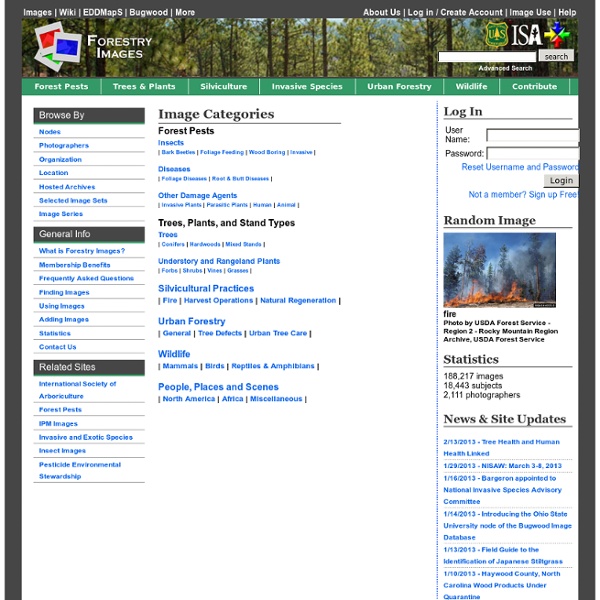



IUFRO Alien invasive species and international trade What does this IUFRO Unit do? The IUFRO Unit 7.03.12 has been established to examine global forestry issues related to the unwanted international movement of alien invasive species, including fungi, insects, nematodes, and plants. The increasing emphasis on pathways for movement of alien invasive species, especially those associated with packaging wood and plants for planting will provide a broad focus for the work of the unit. This emphasis provides an opportunity to integrate across a range of invasive organisms so that links to other IUFRO Working Parties dealing with insects, pathogens and invasive plants will be a priority. There are close relations with other IUFRO working parties as well as the International Forestry Quarantine Research Group (IFQRG) affiliated with the Food and Agriculture Organization, International Plant Protection Convention. Specific objectives of the Unit Activities of the Unit These will include regular meetings at 1-2 year intervals. For further information
Bioimages The Forest Unseen: A Year’s Watch in Sewanee’s Forest | Guest Blog The western escarpment of the Cumberland Plateau, seen from Piney Point, Sewanee, TN. David Haskell observed one square meter of forest here. Specifically, this small patch of forest sits on the slope at the center of the photo, just around the ridge. (credit: David G. Thoreau went to the woods to suck out all the marrow of life. I went to the forest seeking a new way to experience the natural world. So, I watched a small patch of leaves and jumbled rocks tucked in a notch on a wooded slope. The Forest Unseen, published by Viking/Penguin. On almost every visit, the forest surprised me with interesting creatures (scuttling shrews, waddling salamanders, peculiar mushrooms) or ecological interactions (bees covered in pink pollen, writhing parasitic worms, ants wrestling with caterpillars). The forest, I soon discovered, is ruled by a proletariat of tiny and seemingly obscure creatures. Lying down, I pressed my nose to the litter: fat, warm, truffly smells.
Forest Health Authored By: D. J. Moorhead, G. K. The capacity of the southern Appalachian region to provide extensive and diverse resource values is seriously compromised by unhealthy forest conditions. Forest Insects Conifer Insects Hardwood Insects Forest Diseases Nonnative Invasive Species Nonnative Invasive Plants Nonnative Invasive Insects and Pathogens Invasive Plant Control Air Quality Subsections found in Forest Health Forest Insects : Southern Appalachian trees serve as hosts for a variety of insects. Tree of Life Web Project The Tree of Life Web Project (ToL) is a collaborative effort of biologists and nature enthusiasts from around the world. On more than 10,000 World Wide Web pages, the project provides information about biodiversity, the characteristics of different groups of organisms, and their evolutionary history (phylogeny). Each page contains information about a particular group, e.g., salamanders, segmented worms, phlox flowers, tyrannosaurs, euglenids, Heliconius butterflies, club fungi, or the vampire squid.
Protecting, Sustaining, Advocacy -North Carolina Urban Forest Council Continental Dialogue on Non-Native Forest Insects & Diseases Temperate Forest Four-Season Forests Temperate forests grow between the tropics and the polar regions in both the Northern and Southern Hemispheres. They have four distinct seasons with a well-defined winter. Temperate forests have a moderate climate. Trees of Temperate Forests Temperate forests include a mix of trees that belong to three main groups. Deciduous trees lose their leaves when the days grow shorter and the weather turns cold. Coniferous trees have seeds that develop in cones. Broad-leaved evergreens grow in temperate forests in warm parts of the world like New Zealand, Australia, southwest South America, and the Mediterranean. In Temperate Forests, Litter Is a Good Thing Fallen leaves create leaf litter. A Different Look Each Season Seasons change the look of temperate forests every few months. Winter – Forests may look rather lifeless during this time, especially if the forest is made up mainly of deciduous trees. Spring – Days begin to lengthen and get warmer. Precipitation ©G.Ellis/GLOBIO.org
Stop The Beetle (Emerald Ash Borer Beetle) World's Most Beautiful Trees Photography - One Big Photo The Portland Japanese Garden is a traditional Japanese garden occupying 5.5 acres (22,000 m²), located within Washington Park in the west hills of Portland, Oregon, USA. Photo by: unknown Huge 750 years old sequoia tree, California. Photo by: Michael Nichols Kiss under a cherry blossom tree. Photo by: Korri Crowley Yellow autumn in Central Park, New York. Natural tree tunnel, California. This is not a painting, dead trees park, Namibia. Amazing angel oak tree, Charleston. Black roots on red leaves. Most beautiful wisteria tree in the world. Sagano bamboo forest, Kyoto, Japan. Jacaranda trees in bloom, South Africa. Beautiful cherry blossom road.
Increasing Sustainability of European Forests (ISEFOR) Sanctuaries in India, Wildlife Sanctuaries in India, Indian Sanctuaries Healthy Trees, Healthy Cities